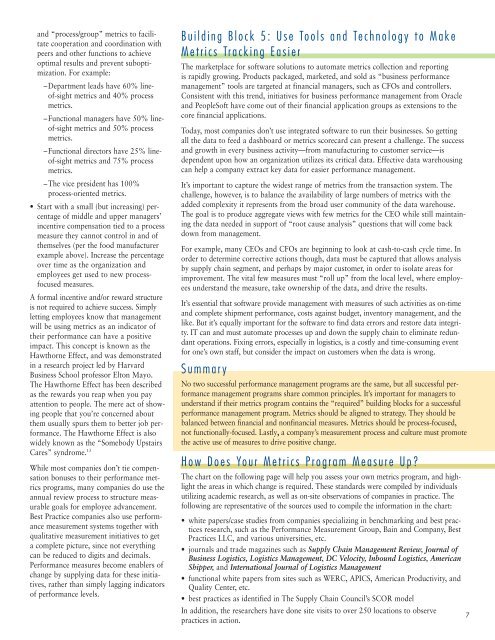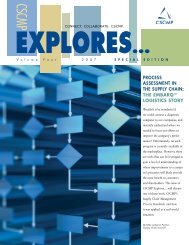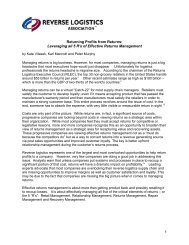is your metrics program measuring up? - Supply Chain Visions
is your metrics program measuring up? - Supply Chain Visions
is your metrics program measuring up? - Supply Chain Visions
You also want an ePaper? Increase the reach of your titles
YUMPU automatically turns print PDFs into web optimized ePapers that Google loves.
and “process/gro<strong>up</strong>” <strong>metrics</strong> to facilitate<br />
cooperation and coordination with<br />
peers and other functions to achieve<br />
optimal results and prevent suboptimization.<br />
For example:<br />
–Department leads have 60% lineof-sight<br />
<strong>metrics</strong> and 40% process<br />
<strong>metrics</strong>.<br />
–Functional managers have 50% lineof-sight<br />
<strong>metrics</strong> and 50% process<br />
<strong>metrics</strong>.<br />
–Functional directors have 25% lineof-sight<br />
<strong>metrics</strong> and 75% process<br />
<strong>metrics</strong>.<br />
–The vice president has 100%<br />
process-oriented <strong>metrics</strong>.<br />
• Start with a small (but increasing) percentage<br />
of middle and <strong>up</strong>per managers’<br />
incentive compensation tied to a process<br />
measure they cannot control in and of<br />
themselves (per the food manufacturer<br />
example above). Increase the percentage<br />
over time as the organization and<br />
employees get used to new processfocused<br />
measures.<br />
A formal incentive and/or reward structure<br />
<strong>is</strong> not required to achieve success. Simply<br />
letting employees know that management<br />
will be using <strong>metrics</strong> as an indicator of<br />
their performance can have a positive<br />
impact. Th<strong>is</strong> concept <strong>is</strong> known as the<br />
Hawthorne Effect, and was demonstrated<br />
in a research project led by Harvard<br />
Business School professor Elton Mayo.<br />
The Hawthorne Effect has been described<br />
as the rewards you reap when you pay<br />
attention to people. The mere act of showing<br />
people that you’re concerned about<br />
them usually spurs them to better job performance.<br />
The Hawthorne Effect <strong>is</strong> also<br />
widely known as the “Somebody Upstairs<br />
Cares” syndrome. 13<br />
While most companies don’t tie compensation<br />
bonuses to their performance <strong>metrics</strong><br />
<strong>program</strong>s, many companies do use the<br />
annual review process to structure measurable<br />
goals for employee advancement.<br />
Best Practice companies also use performance<br />
measurement systems together with<br />
qualitative measurement initiatives to get<br />
a complete picture, since not everything<br />
can be reduced to digits and decimals.<br />
Performance measures become enablers of<br />
change by s<strong>up</strong>plying data for these initiatives,<br />
rather than simply lagging indicators<br />
of performance levels.<br />
Building Block 5: Use Tools and Technology to Make<br />
Metrics Tracking Easier<br />
The marketplace for software solutions to automate <strong>metrics</strong> collection and reporting<br />
<strong>is</strong> rapidly growing. Products packaged, marketed, and sold as “business performance<br />
management” tools are targeted at financial managers, such as CFOs and controllers.<br />
Cons<strong>is</strong>tent with th<strong>is</strong> trend, initiatives for business performance management from Oracle<br />
and PeopleSoft have come out of their financial application gro<strong>up</strong>s as extensions to the<br />
core financial applications.<br />
Today, most companies don’t use integrated software to run their businesses. So getting<br />
all the data to feed a dashboard or <strong>metrics</strong> scorecard can present a challenge. The success<br />
and growth in every business activity—from manufacturing to customer service—<strong>is</strong><br />
dependent <strong>up</strong>on how an organization utilizes its critical data. Effective data warehousing<br />
can help a company extract key data for easier performance management.<br />
It’s important to capture the widest range of <strong>metrics</strong> from the transaction system. The<br />
challenge, however, <strong>is</strong> to balance the availability of large numbers of <strong>metrics</strong> with the<br />
added complexity it represents from the broad user community of the data warehouse.<br />
The goal <strong>is</strong> to produce aggregate views with few <strong>metrics</strong> for the CEO while still maintaining<br />
the data needed in s<strong>up</strong>port of “root cause analys<strong>is</strong>” questions that will come back<br />
down from management.<br />
For example, many CEOs and CFOs are beginning to look at cash-to-cash cycle time. In<br />
order to determine corrective actions though, data must be captured that allows analys<strong>is</strong><br />
by s<strong>up</strong>ply chain segment, and perhaps by major customer, in order to <strong>is</strong>olate areas for<br />
improvement. The vital few measures must “roll <strong>up</strong>” from the local level, where employees<br />
understand the measure, take ownership of the data, and drive the results.<br />
It’s essential that software provide management with measures of such activities as on-time<br />
and complete shipment performance, costs against budget, inventory management, and the<br />
like. But it’s equally important for the software to find data errors and restore data integrity.<br />
IT can and must automate processes <strong>up</strong> and down the s<strong>up</strong>ply chain to eliminate redundant<br />
operations. Fixing errors, especially in log<strong>is</strong>tics, <strong>is</strong> a costly and time-consuming event<br />
for one’s own staff, but consider the impact on customers when the data <strong>is</strong> wrong.<br />
Summary<br />
No two successful performance management <strong>program</strong>s are the same, but all successful performance<br />
management <strong>program</strong>s share common principles. It’s important for managers to<br />
understand if their <strong>metrics</strong> <strong>program</strong> contains the “required” building blocks for a successful<br />
performance management <strong>program</strong>. Metrics should be aligned to strategy. They should be<br />
balanced between financial and nonfinancial measures. Metrics should be process-focused,<br />
not functionally-focused. Lastly, a company’s measurement process and culture must promote<br />
the active use of measures to drive positive change.<br />
How Does Your Metrics Program Measure Up?<br />
The chart on the following page will help you assess <strong>your</strong> own <strong>metrics</strong> <strong>program</strong>, and highlight<br />
the areas in which change <strong>is</strong> required. These standards were compiled by individuals<br />
utilizing academic research, as well as on-site observations of companies in practice. The<br />
following are representative of the sources used to compile the information in the chart:<br />
•white papers/case studies from companies specializing in benchmarking and best practices<br />
research, such as the Performance Measurement Gro<strong>up</strong>, Bain and Company, Best<br />
Practices LLC, and various universities, etc.<br />
• journals and trade magazines such as S<strong>up</strong>ply <strong>Chain</strong> Management Review, Journal of<br />
Business Log<strong>is</strong>tics, Log<strong>is</strong>tics Management, DC Velocity, Inbound Log<strong>is</strong>tics, American<br />
Shipper, and International Journal of Log<strong>is</strong>tics Management<br />
• functional white papers from sites such as WERC, APICS, American Productivity, and<br />
Quality Center, etc.<br />
• best practices as identified in The S<strong>up</strong>ply <strong>Chain</strong> Council’s SCOR model<br />
In addition, the researchers have done site v<strong>is</strong>its to over 250 locations to observe<br />
practices in action.<br />
7




